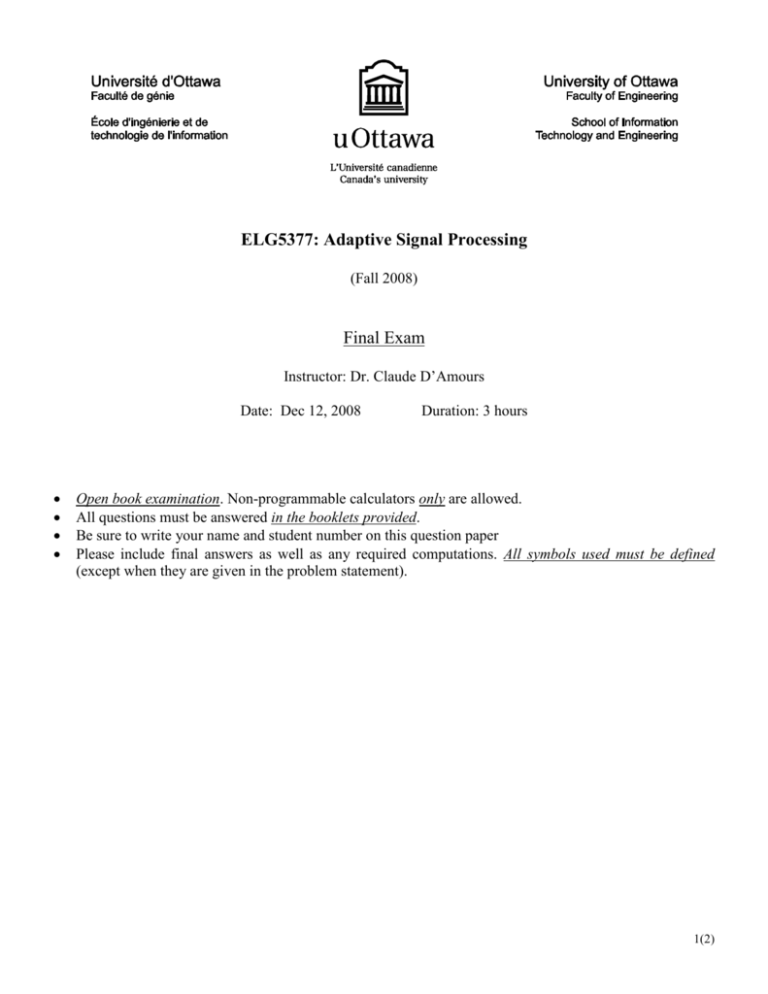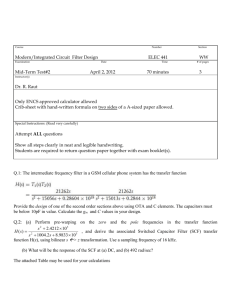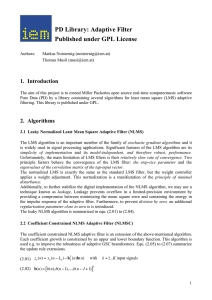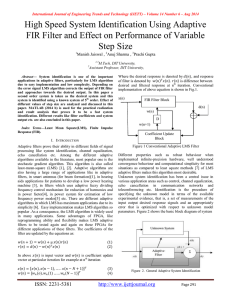ELG4105
advertisement

ELG5377: Adaptive Signal Processing (Fall 2008) Final Exam Instructor: Dr. Claude D’Amours Date: Dec 12, 2008 Duration: 3 hours Open book examination. Non-programmable calculators only are allowed. All questions must be answered in the booklets provided. Be sure to write your name and student number on this question paper Please include final answers as well as any required computations. All symbols used must be defined (except when they are given in the problem statement). 1(2) Question 1 (10 points = 4+6) An M tap adaptive uses the LMS algorithm to update its tap weights. The tap input vector u(n) = [u(n), u(n1), …, u(n-M+1)]T and the filter weight vector is w(n) = [w0(n), w1(n), …, wM-1(n)]T. Answer the following questions: (a) If we use = 2/E[|u(n)|2], will the algorithm converge? Justify your answer. (b) Suppose that max of R = E[u(n)uH(n)] is much greater than all other eigenvalues of R. Assuming that the value of used in (a) leads to convergence of the algorithm, discuss the use of this value of on the misadjustment and mean square deviation of the algorithm. Consider both the stationary and nonstationary cases. Question 2 (35 points: all subquestions = 5 points) At time n, the input to a 2 tap filter is u(n) = d(n)-0.3d(n-1)+I(n)+N(n), where d(n) is the desired output, I(n) is an interference signal and N(n) is white noise with 0 mean and variance 0.2. Let u(n) = [u(n), u(n-1)]T, and Ru = E[u(n)uH(n)]. Let E[d(n)]= E[I(n)] = E[N(n)] = 0 and E[d(n)d*(n-i)] = 2e-i and E[I(n)I*(n-i)] = 10.25|i| for |i|<4 and 0 otherwise. Furthermore d(n), I(n) and N(n) are all drawn from mutually independent stochastic processes. (a) Design a two-tap Wiener filter for this system. (b) If yo(n) is the output of your filter, what is E[|d(n)-yo(n)|2]? (c) Suppose we select a fixed filter wx = [0.6 -0.2]T for which the output y(n) = wxHu(n). What is E[|d(n)y(n)|2] for this filter? (d) Rather than using the Wiener filter, let us use an adaptive filter that uses the LMS algorithm. What is the maximum value for that we can use? (e) Let 1 = 0.1max and 2 = 0.5max, where max is the answer found in (c). Which value of will allow a faster convergence? Which will provide a better misadjustment? Justify your answer. (f) If we used the RLS algorithm with = 0.9, will that improve convergence and/or misadjustment compared to the LMS based filters of (e)? (g) Let = 0.05max. What is the mean square error between the desired output and the filter output, J(∞)? Question 3 (8 points) Under what circumstances is it beneficial to use the fast block LMS algorithm instead of the conventional LMS algorithm? Question 4 (7 points) Consider the correlation matrix (n) = u(n)uH(n) + I, where is a small positive constant. Use the matrix inversion lemma to evaluate P(n) = -1(n). Question 5 (10 points) The inputs to a two tap filter for n=1, 2, … 5 are u(1) = 3, u(2) = 0.5 u(3) = -1, u(4) = 0.9, u(5) = -0.8. The desired outputs for n=2, 3, …5, are d(2) = 1, d(3) = -1, d(4) = 1 and d(5) = 1. Find the two tap Least Squares solution to this problem as well as the minimum sum of error squares. 2(2)











